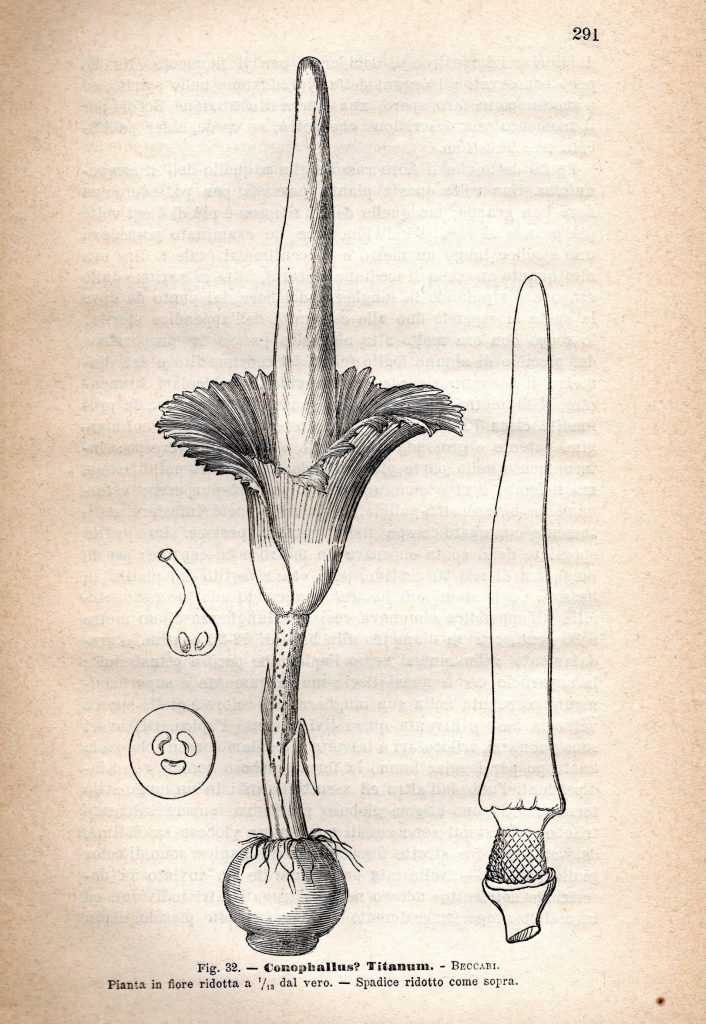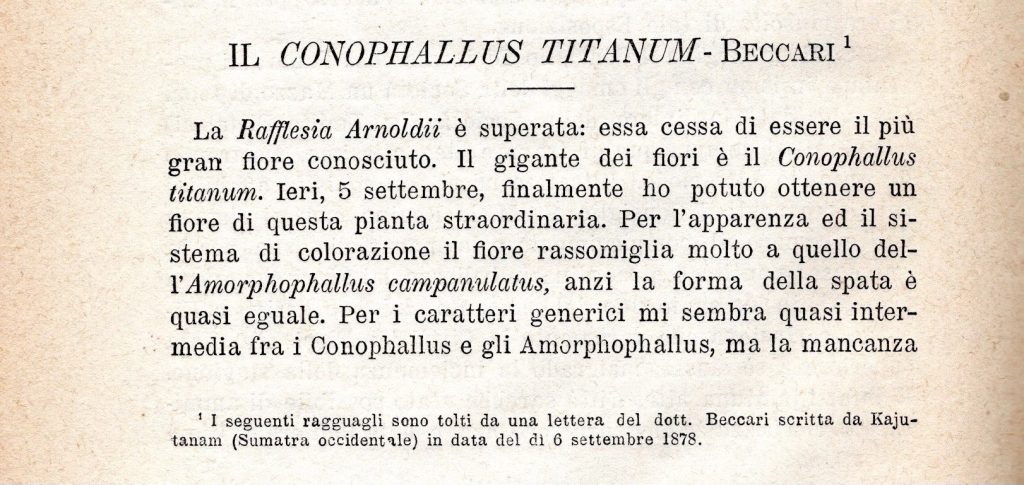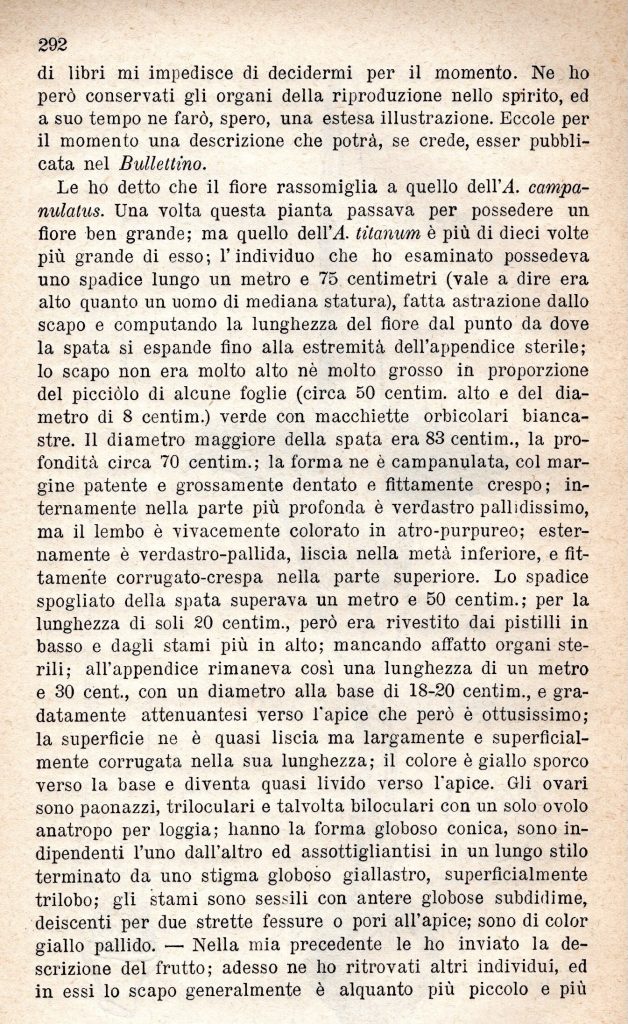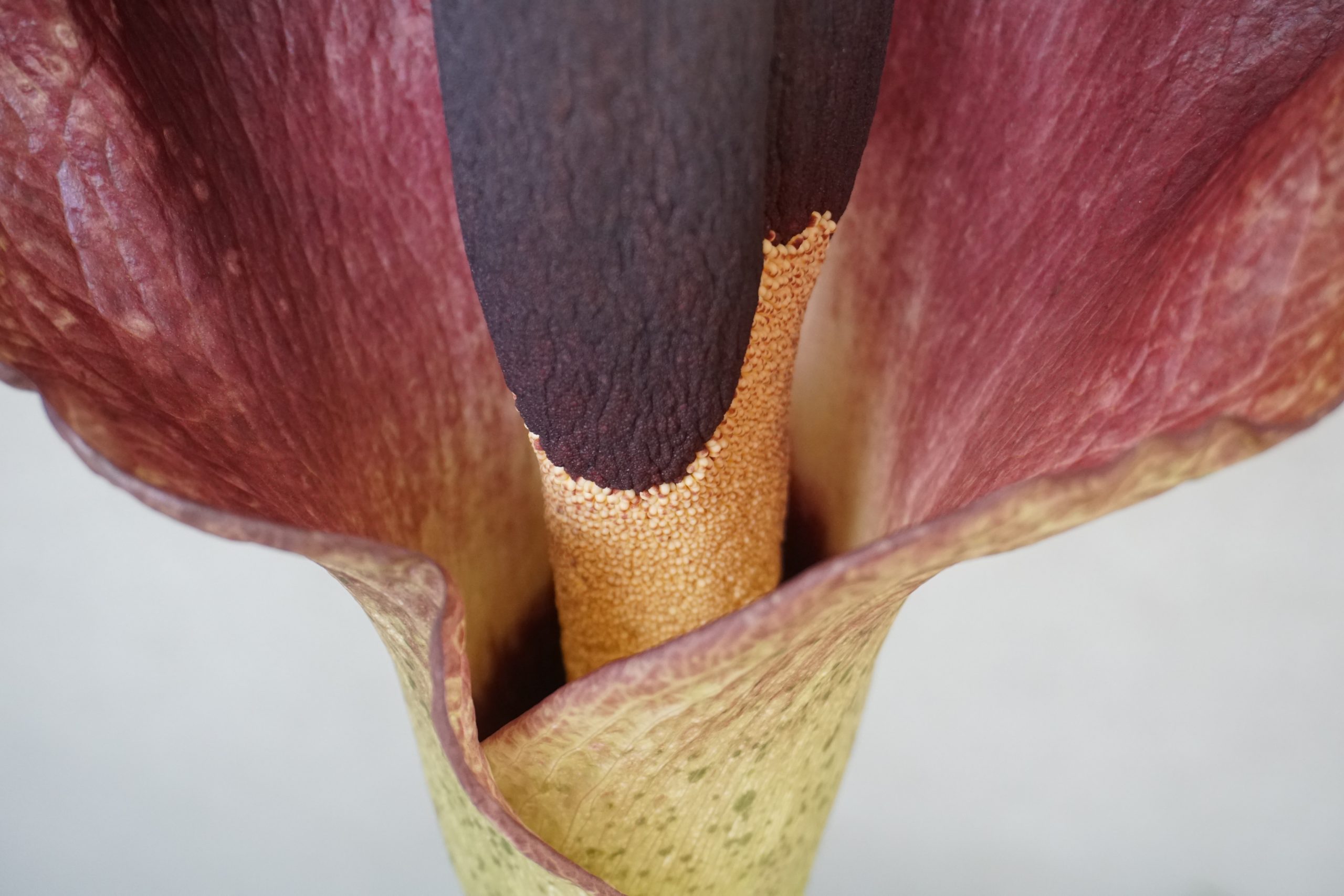



In Italian:
La Rafflesia Arnoldii è superata: essa cessa di essere il più gran fiore conosciuto. Il gigante dei fiori è il Conophallus titanum. Ieri, 5 settembre, finalmente ho potuto ottenere un fiore di questa pianta straordinaria. Per l'apparenza ed il sistema di colorazione il fiore rassomiglia molto a quello dell' Amorphophallus campanulatus, anzi la forma della spata è quasi eguale. Per i caratteri generici mi sembra quasi intermedia fra i Conophallus e gli Amorphophallus, ma la mancanza di libri mi impedisce di decidermi per il momento. Ne ho però conservati gli organi della riproduzione nello spirito, ed a suo tempo ne farò, spero, una estesa illustrazione. Eccole per il momento una descrizione che potrà, se crede, esser pubblicata nel Bullettino.
Le ho detto che il fiore rassomiglia a quello dell'A. campanulatus. Una volta questa pianta passava per possedere un fiore ben grande; ma quello dell'A. titanum è più di dieci volte più grande di esso; l'individuo che ho esaminato possedeva uno spadice lungo un metro e 75 centimetri (vale a dire era alto quanto un uomo di mediana statura), fatta astrazione dallo scapo e computando la lunghezza del fiore dal punto da dove la spata si espande fino alla estremità dell'appendice sterile; lo scapo non era molto alto nè molto grosso in proporzione del picciolo di alcune foglie (circa 50 centim. alto e del diametro di 8 centim.) verde con macchiette orbicolari biancastre. Il diametro maggiore della spata era 83 centim., la profondità circa 70 centim.; la forma ne è campanulata, col margine patente e grossamente dentato e fittamente crespo; internamente nella parte più profonda è verdastro pallidissimo, ma il lembo è vivacemente colorato in atro-purpureo; esternamente è verdastro-pallida, liscia nella metà inferiore, e fittamente corrugato-crespa nella parte superiore. Lo spadice spogliato della spata superava un metro e 50 centim.; per la lunghezza di soli 20 centim., però era rivestito dai pistilli in basso e dagli stami più in alto; mancando affatto organi ste-rili; all'appendice rimaneva cosi una lunghezza di un metro e 30 cent., con un diametro alla base di 18-20 centim., e gradatamente attenuantesi verso l'apice che però è ottusissimo; la superficie ne è quasi liscia ma largamente e superficialmente corrugata nella sua lunghezza; il colore è giallo sporco verso la base e diventa quasi livido verso l'apice. Gli ovari sono paonazzi, triloculari e talvolta biloculari con un solo ovolo anatropo per loggia; hanno la forma globoso conica, sono indipendenti l'uno dall'altro ed assottigliantisi in un lungo stilo terminato da uno stigma globoso giallastro, superficialmente trilobo; gli stami sono sessili con antere globose subdidime, deiscenti per due strette fessure o pori all'apice; sono di color giallo pallido. — Nella mia precedente le ho inviato la descrizione del frutto; adesso ne ho ritrovati altri individui, ed in essi lo scapo generalmente è alquanto più piccolo e più corto del picciolo delle più grandi foglie. Il primo individuo che trovai in frutto aveva lo scapo gia caduto al suolo e pu-trefatto, per cui non potei bene apprezzarne l'altezza. Ho conservato nello spirito tutto uno spadice fruttifero: esso è 60 centimetri lungo, il peduncolo di esso superava un metro e 50 centimetri e aveva il diametro di 10 centim. Le foglie rassomigliano moltissimo quelle dell'A. campanulatus in proporzioni molto maggiori.
In English:
The Raflesia Arnoldii is surpassed: it ceases to be the largest known flower. The giant of flowers is the Conophallus titanum. Yesterday, September 5th, I finally obtained a flower of this extraordinary plant. For its appearance and coloration system, the flower closely resembles that of the Amorphophallus campanulatus; indeed, the shape of the spathe is almost identical. For the generic characters, it seems almost intermediate between Conophallus and Amorphophallus, but the lack of books prevents me from deciding for the moment. However, I have preserved the reproductive organs in spirit, and in due course, I hope to provide a detailed illustration. Here, for the moment, is a description that can, if you wish, be published in the Bulletin.
I told you that the flower resembles that of A. campanulatus. Once this plant was considered to possess a very large flower; but that of A. titanum is more than ten times larger than it; the individual I examined had a spadix 175 centimeters long (that is, as tall as a man of medium height), disregarding the scape and computing the length of the flower from where the spathe expands to the tip of the sterile appendix; the scape was not very tall or thick in proportion to the petiole of some leaves (about 50 centimeters tall and 8 centimeters in diameter), green with orbicular white patches. The largest diameter of the spathe was 83 centimeters, the depth about 70 centimeters; it is bell-shaped, with a spreading and coarsely toothed margin, densely curly; internally in the deepest part, it is very pale greenish, but the lobe is vividly colored in dark purple; externally it is pale greenish, smooth in the lower half, and densely wrinkled and curly in the upper part. The spadix, stripped of the spathe, exceeded one meter and 50 centimeters; in length, only 20 centimeters, however, it was covered by pistils below and stamens higher up; completely lacking sterile organs; the appendix thus remained a length of one meter and 30 centimeters, with a diameter at the base of 18-20 centimeters, gradually tapering towards the apex, which, however, is very blunt; the surface is almost smooth but broadly and superficially wrinkled in its length; the color is dirty yellow towards the base and becomes almost livid towards the apex. The ovaries are purplish, three-lobed and sometimes two-lobed with a single anatropous ovule per chamber; they are globose-conical in shape, independent of each other and tapering into a long style terminated by a globular yellowish stigma, superficially three-lobed; the stamens are sessile with subdidymous globose anthers, dehiscing by two narrow fissures or pores at the apex; they are pale yellow in color. — In my previous letter, I sent you the description of the fruit; now I have found other individuals, and in them the scape is generally somewhat smaller and shorter than the petiole of the largest leaves. The first individual I found with fruit had the scape already fallen to the ground and rotten, so I could not accurately assess its height. I have preserved in spirit a whole fruiting spadix: it is 60 centimeters long, its peduncle exceeded one meter and 50 centimeters and had a diameter of 10 centimeters. The leaves closely resemble those of A. campanulatus but in much larger proportions.

